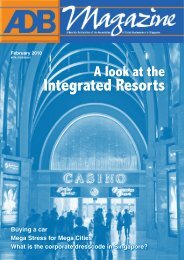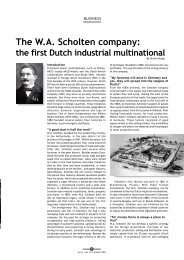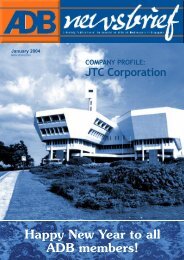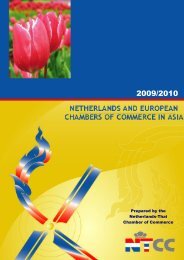June - July 2013 - Association of Dutch Businessmen
June - July 2013 - Association of Dutch Businessmen
June - July 2013 - Association of Dutch Businessmen
Create successful ePaper yourself
Turn your PDF publications into a flip-book with our unique Google optimized e-Paper software.
Travel<br />
Destination: Myanmar<br />
Text and Photos Frank Kuijsters<br />
Before we left on our trip to Myanmar, I had read<br />
extensively about this Southeast Asian country, and not<br />
just because its history <strong>of</strong> military dictatorship demands<br />
due diligence from travelers. Owing to how fast things have<br />
been changing, nothing I read had actually prepared me.<br />
Most everything I experienced - from the relentless street<br />
scene in Yangon to the serene temples <strong>of</strong> Bagan, the touristy<br />
monasteries <strong>of</strong> Mandalay and the amazing floating gardens<br />
at Lake Inle - was more complex, vibrant and pr<strong>of</strong>ound than<br />
I had imagined. It was the type <strong>of</strong> holiday where your brain<br />
is on all the time, because everything you see invites further<br />
questions. If things continue to change as fast as they have<br />
been, it will be different to visit even six months from now.<br />
Since the contested elections in 2010, Myanmar - under<br />
sanctions from the U.S. and Europe for decades - has been<br />
steadily moving towards democratic change. What began<br />
as a whisper <strong>of</strong> transformation has grown louder as timid,<br />
but extraordinarily hopeful signs point toward a lasting shift.<br />
The release <strong>of</strong> longtime opposition leader Aung San Suu Kyi,<br />
known as the Lady, from house arrest in 2010 was a marker<br />
for me. Just three years ago locals were not able to access<br />
online blogs, could not exchange U.S. dollars and could get<br />
into a lot <strong>of</strong> trouble for distributing pictures <strong>of</strong> the Lady or<br />
her party, the National League for Democracy (NLD). Now,<br />
the country is open and her pictures are sold openly. Obama<br />
has visited. Boycotts have been lifted, and everyone wants<br />
to rush in to see the land that Kipling immortalized in poetry<br />
before it becomes too Westernized.<br />
Travelers are right to want to go, but not if they are the<br />
kind who want to stay in fancy hotels and check <strong>of</strong>f major<br />
sights robotically. The infrastructure remains primitive with<br />
more than half <strong>of</strong> the city <strong>of</strong> Yangon commonly still without<br />
power. Credit cards are accepted almost nowhere. The first<br />
ATMs are just arriving; we went to an <strong>of</strong>fice building where<br />
the money exchangers were set up between curio shops and<br />
the exchange rates were different for brand new and worn<br />
bills. Most <strong>of</strong> the time they don’t even except worn US$<br />
bills. However, adventurous souls who can handle changes<br />
in plan, are open to discovery and appreciate the magic <strong>of</strong><br />
foreign encounters will find themselves enchanted.<br />
On the first day <strong>of</strong> our eight-day tour through Myanmar<br />
we went to the legendary Shwegadon Pagodain Yangon. A<br />
massive gold stupa rising more than 330 feet into the sky<br />
sits at the center <strong>of</strong> dozens <strong>of</strong> smaller temples. Some were<br />
painted with murals depicting stories <strong>of</strong> Buddha; others<br />
were adorned with mirrors and tiles and still others were<br />
filled with gold Buddhas. There were even pulsing electrical<br />
neon Buddhas. Young and old came to pour water over the<br />
Buddhas at stations for each day <strong>of</strong> the week or to make<br />
gold leaf <strong>of</strong>ferings to Buddha, like we did, or to pray, or even<br />
take strolls with their lovers or children. We were among the<br />
many Westerners in the vast complex that wanted to watch<br />
the changes <strong>of</strong> the color <strong>of</strong> the Pagoda in the sunset. This<br />
was for us one <strong>of</strong> the highlights <strong>of</strong> Yangon. Luckily, we also<br />
caught glimpses <strong>of</strong> the crumbling grand colonial buildings,<br />
which may or may not be preserved as foreign investment<br />
pours into the city.<br />
The next day we flew up to Began after a two-hour delay<br />
due to fog, to the land <strong>of</strong> one thousand temples, but its<br />
fields are really strewn with many thousands <strong>of</strong> temples.<br />
Bagan, like Luxor or Angkor Wat, cannot be comprehended<br />
until you see it in person. In every direction rise the spires<br />
<strong>of</strong> stupas in varying degrees <strong>of</strong> decay, like ancient prayers<br />
laid in brick and left over for centuries. The place is known<br />
as the birthplace <strong>of</strong> Theravada Buddhism. The temples and<br />
stupas were built in the era between the 11th and 13th<br />
centuries, and still exist today as a National Heritage Site on<br />
the banks <strong>of</strong> the Ayeyarwady river. It is impossible to see all<br />
the amazing Pagodas and therefore it is necessary to select<br />
a few outstanding Pagodas to see in detail. The highlights<br />
are Ananda Temple, Manuha, Nanphaya, Wet Gyi In Gu<br />
Pyauk Gyi, Shwezigone Stupa, Mingalar Zedi, Damayangyi<br />
26















